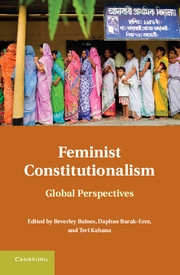Book contents
- Frontmatter
- Contents
- Foreword
- Contributors
- Introduction
- Part I Feminism as a Challenge to Constitutional Theory
- Part II Feminism and Judging
- 4 Her-meneutics
- 5 Intuition and Feminist Constitutionalism
- 6 Women Judges, “Maiden Speeches,” and the High Court of Australia
- 7 Will “Watertight Compartments” Sink Women's Charter Rights? The Need for a New Theoretical Approach to Women's Multiple Rights Claims under the Canadian Charter of Rights and Freedoms
- 8 Constitutional Adjudication and Substantive Gender Equality in Hong Kong
- Part III Feminism, Democracy, and Political Participation
- Part IV The Constitutionalism of Reproductive Rights
- Part V Women's Rights, Multiculturalism, and Diversity
- Part VI Women between Secularism and Religion
- Index
- References
6 - Women Judges, “Maiden Speeches,” and the High Court of Australia
Published online by Cambridge University Press: 05 June 2012
- Frontmatter
- Contents
- Foreword
- Contributors
- Introduction
- Part I Feminism as a Challenge to Constitutional Theory
- Part II Feminism and Judging
- 4 Her-meneutics
- 5 Intuition and Feminist Constitutionalism
- 6 Women Judges, “Maiden Speeches,” and the High Court of Australia
- 7 Will “Watertight Compartments” Sink Women's Charter Rights? The Need for a New Theoretical Approach to Women's Multiple Rights Claims under the Canadian Charter of Rights and Freedoms
- 8 Constitutional Adjudication and Substantive Gender Equality in Hong Kong
- Part III Feminism, Democracy, and Political Participation
- Part IV The Constitutionalism of Reproductive Rights
- Part V Women's Rights, Multiculturalism, and Diversity
- Part VI Women between Secularism and Religion
- Index
- References
Summary
[T]he way one tells one's story is a way of positioning one's gender identity vis-à-vis an audience taking part in the process…as an ongoing process of articulating sameness and difference.
On February 3, 2009, a historic event occurred in the Australian legal community. Of the seven judges of the High Court of Australia, three are now women: Justices Susan Crennan, Susan Kiefel, and Virginia Bell. Never before has Australia's constitutional and ultimate court of appeal achieved near equality in the gender composition of its bench. In 1987, when Mary Gaudron was appointed as the first woman to the court, this achievement may have seemed a far-off dream.
Since the Australian High Court was established in 1903, ceremonies have been held to mark the swearing-in of a new Justice. This chapter utilizes the speeches made at the swearing-in ceremonies of Gaudron, Crennan, Kiefel, and Bell as a prism to explore the representation of women judges in the Australian legal community, and in particular, the Australian High Court.
These ceremonies are a rich resource by virtue of the two kinds of speeches made on these occasions. First, leaders of the Australian legal community make speeches welcoming the new High Court judge to the bench. In a legal system where federal judges are chosen behind closed doors, the welcome speeches have performed a key role in introducing the new judges to the public, and attesting to their skills as lawyer and judge. Importantly, the litany of a new judge’s accomplishments on these occasions contextualizes the concept of “merit” in aHigh Court appointment. Furthermore, the speech by the Commonwealth Attorney-General has provided a measure of public justification of his decision to appoint a particular judge. This chapter explores how the welcome speakers have grappled with the novelty of the feminine in the stories about the four female High Court judges. I argue that gender too often dominated this narrative, to a discriminatory and feminizing effect. In this regard, however, Bell’s ceremony may signal a new direction in the Australian legal community’s attitude toward female judges.
- Type
- Chapter
- Information
- Feminist ConstitutionalismGlobal Perspectives, pp. 113 - 131Publisher: Cambridge University PressPrint publication year: 2012
References
- 2
- Cited by

